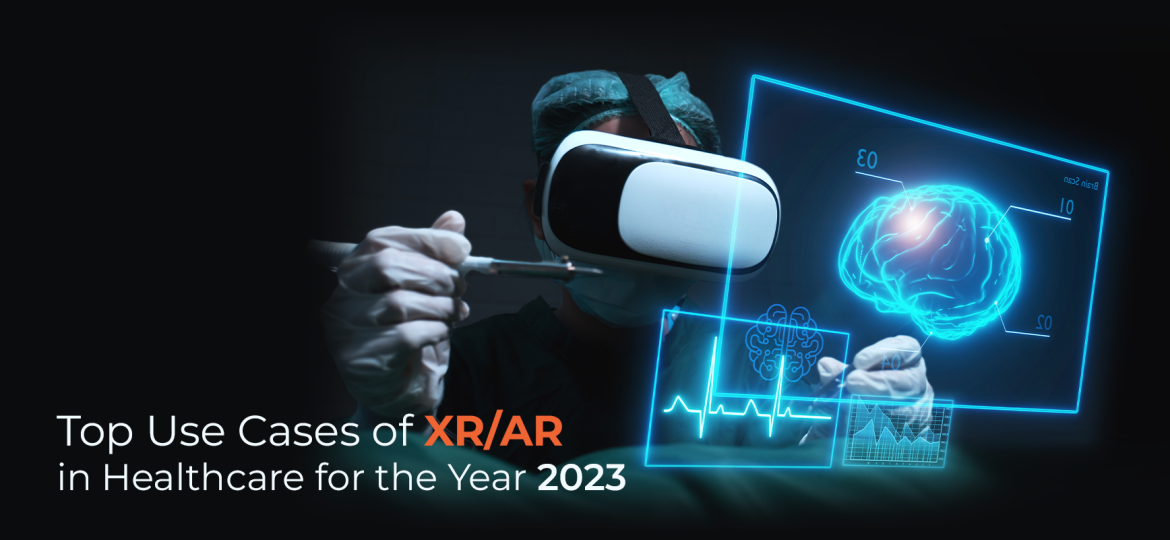
Digital transformation has a massive impact on the performance of nearly all sectors, and healthcare is no exception. The worldwide market for digital health is projected to exceed 480 billion by 2028, and 95% of health system leaders have agreed that it is vital for them to invest in digital transformation. XR (Extended Reality) and AR (Augmented Reality) technologies have rapidly gained traction in healthcare, providing healthcare professionals and patients with immersive, interactive, and personalized experiences. This article will summarize the top use cases of XR/AR, accelerating the pace of digital transformation in the healthcare industry for 2023.
What does XR mean?
Extended Reality (XR) is an umbrella that encompasses Augmented Reality (AR), Virtual Reality (VR), Mixed Reality (MR), and everything in between.Although VR and AR offer a wide range of revolutionary experiences, XR relies on the same underlying technologies. Below is a glimpse of Intellectsoft’s survey as they unveil their predictions for the latest trends in the healthcare sector for the year 2023. We have summarized what industry leaders are foreseeing:

1- Enhanced patient education and engagement
Step into the world of XR-based solutions, where patients can tap into a realm of possibilities when medical help seems out of reach or when specific issues don’t demand a physical presence of a professional. With XR technology, patients can:

- Bring their symptoms to life by using captivating visual stimuli to explain what they’re experiencing vividly.
- Keep tabs on their healing journey by tracking progress and milestones along the way.
- Elevate their physical therapy game by incorporating XR elements that make the process more engaging and effective.
- Receive much-needed guidance and assistance from nearby medical professionals, all through the wonders of XR.
- Gain a deeper understanding of their condition, empowering them to make informed decisions about their health.
- Peek into their medical data, offering them a valuable glimpse into their health records.
2- VR surgical training
A 2019 study by Imperial College London concludes that 83% of VR-trained participants could complete spinal surgery with minimal guidance, whereas 0% of traditionally trained healthcare professionals could accomplish the same task.

In the past, medical professionals, particularly would-be surgeons, used to rely on traditional methods like cadavers to learn and practice their surgical skills. However, these methods are time-consuming, expensive, and sometimes inaccurate in mimicking real-life scenarios.
On the other hand, XR technology provides medical professionals with immersive and efficient solutions to enhance their learning and training in surgical procedures. Utilizing XR-based surgery simulations offers a secure and lifelike platform for professionals to engage in experimentation, training, and collaborative practices.
3- XR in medical education
Remote education gained momentum during the pandemic and opened various medical education and training possibilities. However, when it comes to hands-on practices, offline practical classes play a significant role. Immersive learning experiences are a tangible way to assist medical students and healthcare workers by:

- Simplifying comprehension of intricate concepts
- Enabling a 3D exploration of human anatomy without the need for a mannequin or physical equipment
- Integrating diverse sources and data into a unified platform
- Providing a first-person view of professionals in action, facilitating observation
- Translating medical education into practical, real-life scenarios
4- Augmented reality surgeries
Augmented reality (AR) surgeries revolutionize medicine by seamlessly integrating virtual information with the physical world during surgical procedures. AR surgeries enhance precision, efficiency, and safety by overlaying real-time digital imagery and data onto the surgeon’s view.

Surgeons can access crucial information, such as patient records, diagnostic images, and real-time guidance, directly within their field of view, eliminating the need to shift attention away from the operating area. This technology empowers surgeons to make more informed decisions, enhances their spatial awareness, and ultimately improves patient outcomes. AR surgeries represent a groundbreaking advancement that merges the best of technology and medical expertise to shape the future of the surgical practice.
5- VR for pain management
Virtual Reality (VR) has emerged as a promising tool for pain management in various healthcare settings. By immersing individuals in virtual environments, VR can effectively distract and engage their senses, diverting attention away from pain and discomfort. This immersive experience can particularly benefit patients undergoing painful procedures, chronic pain management, and rehabilitation.
VR for pain management offers several advantages. It provides a non-pharmacological and non-invasive approach, reducing the reliance on medications for pain relief. Additionally, VR experiences can be tailored to individual preferences, offering a wide range of immersive scenarios and interactive activities to help individuals relax and focus their attention elsewhere.
Through VR, patients can be transported to calming and soothing environments, such as serene natural landscapes, tranquil beaches, or peaceful gardens. They can also engage in interactive games, guided meditations, or virtual therapy sessions that aid in pain distraction and relaxation.
This is an area in which PROVEN Reality has been active for quite some time. An overview of our pain management VR application:
6- AR for pharma marketing and advertising
Augmented Reality (AR) technology is transforming pharmaceutical marketing and advertising, offering innovative ways to engage and educate healthcare professionals and consumers.
AR enables pharmaceutical companies to create interactive, immersive experiences that bring their products to life. By overlaying digital content in the real world through smartphones, tablets, or smart glasses, AR allows users to visualize and explore pharmaceutical products more engaging and informative.

For healthcare professionals, AR can provide valuable educational tools. By using AR applications, medical representatives can showcase the mechanism of action, dosage forms, and key features of medications directly to physicians and other healthcare providers. This interactive approach enhances understanding and facilitates more meaningful discussions around product benefits, improving engagement and knowledge retention.
Apart from the aforementioned points, XR technologies will also be increasingly used in improved first-aid, XR-assisted therapy, AR diagnosis, and simplified hospital navigation, according to the same survey.
If you have any queries about this or any other article, please drop us a line here.

